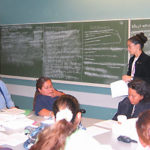| By JOMAY STEEN
Rapid City Journal March 28, 2008 RAPID CITY, S.D. (AP) – Within his lifetime, Stephen Yellowhawk has fought stereotypes about his American Indian culture and heritage. When a recent art contest opened with a theme asking how the use of commercial tobacco had impacted the Lakota culture, traditions and values, it resonated with Yellowhawk’s personal goal to keep youths healthy and tobacco-free. For the first-time art contestant, the Black Hills Center for American Indian Health’s ”The Oniyan Wakan” (”Sacred Breath”) art contest offered an opportunity to display his skills at beadwork and the cultural knowledge he wanted to share. ”It all fell together,” he said. Patricia Nez Henderson, Black Hills Center for American Indian Health vice president, was pleased with the 200 contest submissions. Funded through a grant from the Legacy Foundation and partnered with Sioux San IHS and South Dakota Quit Line, the goal was to provide education and increase smoking cessation for the Native community living in Rapid City. ”It’s been a challenge,” she said of achieving the goal. According to Henderson, the tobacco industry has long targeted American Indians as a subgroup for its products, using Native images and names to market its products while also sponsoring tribal rodeos, athletic tournaments and pow wows with money and handing out cartons of cigarettes. ”It worked,” she said of the industry hooking its target. Commercial tobacco today is not what Native tribes introduced to the colonists, she said. Cigarettes and other tobacco products are saturated with 4,000 different chemicals, 300 of which are cancer-causing. Tobacco’s detrimental health effects on the Northern Plains tribes have been documented and linked to lung cancer, of which South Dakota tribes have some of the highest rates in the nation. Also impacting tribes are heart disease, colorectal cancer, diabetes, SIDS, asthma and developmental delays in children through secondhand smoke. ”It’s an epidemic health crisis with a long-term impact on health delivery systems,” she said. ”Smoking’s impact … is huge.” Quincy Afraid of Lightning, research assistant at the Black Hills Center for American Indian Health, agreed. ”The nicotine in cigarettes and tobacco products is harder to quit than heroine or cocaine,” he said. In 2004 studies, the Centers for Disease Control and Prevention said the smoking rate was highest among American Indians, which is true for tribal communities within the state. ”Fifty percent of high school students and adults in the Northern Plains tribes smoke,” Afraid of Lightning said. Of Native students in school, 95 percent of those students will have tried smoking before graduating from high school; 50 percent of American Indian high school students smoke, he said. ”In Rapid City, there are 10,000 to 12,000 Native Americans in the community, so think that half of them smoke,” he said. Afraid of Lightning said it was a contradiction to his tribe’s value system and a misconception that tobacco was part of the Lakota culture. ”Tobacco doesn’t grow around here, and it never has. What was traditionally used for tobacco was taken from the bark of the red willow tree. … It was never smoked for pleasure or addiction.” This tradition is reflected in Yellowhawk’s artwork. The 25-year-old artist’s beaded scene, called ”Choices,” depicts two Lakota men at a drum. One is a traditional drummer, singing old songs in a colorful, vibrant setting. While on the other side of the drum, Yellowhawk describes the contemporary Lakota singer as overweight, a cigarette dangling from his mouth and disconnected from the beauty of his heritage. ”I’ve seen people like that,” Yellowhawk said of the contemporary man at the drum. ”It inspired me, too. We have accepted cigarette smoking as part of our culture, but that’s not the type of tobacco we used. We didn’t sit around all day smoking cigarettes.” Yellowhawk works with American Indian students and wants to set a good example for them, seeing himself as a role model that they can talk to about their heritage, customs and traditions. ”The tobacco companies are tricking us; cigarette smoking is not traditional in any way,” he said.
|
||
|











